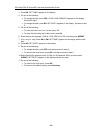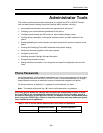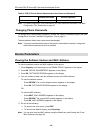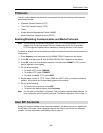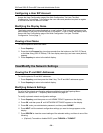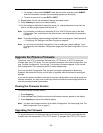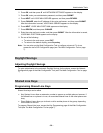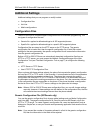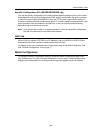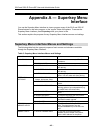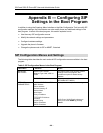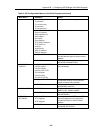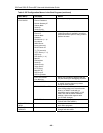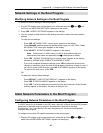
5215 and 5220 IP Phone SIP User and Administrator Guide
- 40 -
Additional Settings
Additional settings that you can program or modify include
• Configuration files
• Hot Line
• Media configurations.
Configuration Files
The 5215 and 5220 IP Phones support configuration files for automatic programming. The
two types of configuration files are
• Generic file: applies its defined settings to all SIP-supported phones.
• Specific file: applies its defined settings to a specific SIP-supported phone.
Configuration files are stored on the HTTP server or the TFTP server. The generic
configuration file is loaded first, then the specific configuration file. If both files contain
settings for the same parameter, the specific configuration file will overwrite the information
from the generic configuration file.
Before a 5215 or 5220 IP Phone can automatically download configuration files from an
HTTP or a TFTP server, you must access the Network Configuration page of the Web
Configuration Tool (see The Web Configuration Tool on page 7) to configure the following
options:
• HTTP Server or TFTP Server
• Use HTTP/TFTP Configuration Files.
When a phone with these settings reboots, the phone first requests the generic configuration
file from the HTTP or TFTP server. If the file exists, it is downloaded and all of its parameters
overwrite the existing parameters on the phone. The phone then requests the specific
configuration file from the HTTP or TFTP server. If the file exists, it is downloaded and all of
its parameters overwrite the existing parameters on the phone. Only the parameters defined
in the configuration files are overwritten on the phone. If the phone requests a configuration
file that is not on the HTTP or TFTP server, settings on the phone do not change.
Note: When a 5215 or 5220 IP Phone uses configuration files, you can still change settings
manually; however, if these settings are also defined in the configuration files, the files
will overwrite the manual settings the next time the phone reboots.
Generic Configuration File (SIPGeneric.cfg)
You use the generic configuration file to change global settings such as Media Configuration
and Voice Mail. The generic configuration file is a text file saved as SIPGeneric.cfg on the
HTTP or TFTP server. To create a generic configuration file, use a text application such as
Notepad or SimpleText, or use your favorite word processing application and save the file as
a text file.
Note: If you exceed the number of characters allowed in a field in the generic configuration
file, then the information in that field will be rejected.



